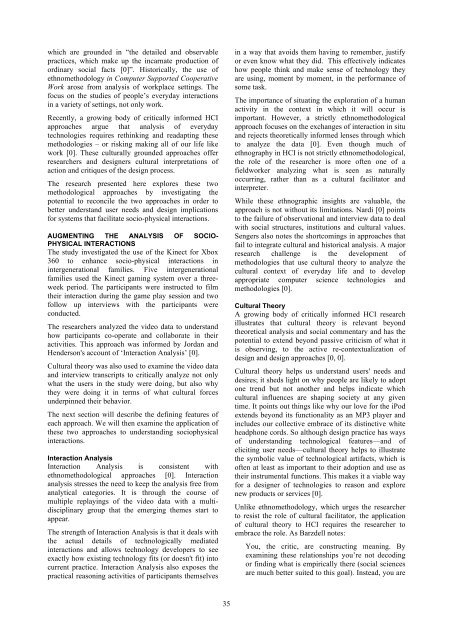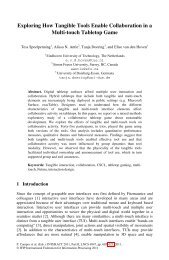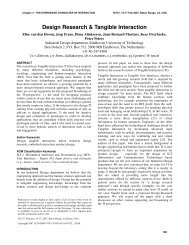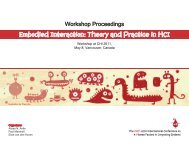Sissy - Elise van den Hoven
Sissy - Elise van den Hoven
Sissy - Elise van den Hoven
You also want an ePaper? Increase the reach of your titles
YUMPU automatically turns print PDFs into web optimized ePapers that Google loves.
which are grounded in “the detailed and observable<br />
practices, which make up the incarnate production of<br />
ordinary social facts [0]”. Historically, the use of<br />
ethnomethodology in Computer Supported Cooperative<br />
Work arose from analysis of workplace settings. The<br />
focus on the studies of people’s everyday interactions<br />
in a variety of settings, not only work.<br />
Recently, a growing body of critically informed HCI<br />
approaches argue that analysis of everyday<br />
technologies requires rethinking and readapting these<br />
methodologies – or risking making all of our life like<br />
work [0]. These culturally grounded approaches offer<br />
researchers and designers cultural interpretations of<br />
action and critiques of the design process.<br />
The research presented here explores these two<br />
methodological approaches by investigating the<br />
potential to reconcile the two approaches in order to<br />
better understand user needs and design implications<br />
for systems that facilitate socio-physical interactions.<br />
AUGMENTING THE ANALYSIS OF SOCIO-<br />
PHYSICAL INTERACTIONS<br />
The study investigated the use of the Kinect for Xbox<br />
360 to enhance socio-physical interactions in<br />
intergenerational families. Five intergenerational<br />
families used the Kinect gaming system over a threeweek<br />
period. The participants were instructed to film<br />
their interaction during the game play session and two<br />
follow up interviews with the participants were<br />
conducted.<br />
The researchers analyzed the video data to understand<br />
how participants co-operate and collaborate in their<br />
activities. This approach was informed by Jordan and<br />
Henderson's account of ‘Interaction Analysis’ [0].<br />
Cultural theory was also used to examine the video data<br />
and interview transcripts to critically analyze not only<br />
what the users in the study were doing, but also why<br />
they were doing it in terms of what cultural forces<br />
underpinned their behavior.<br />
The next section will describe the defining features of<br />
each approach. We will then examine the application of<br />
these two approaches to understanding sociophysical<br />
interactions.<br />
Interaction Analysis<br />
Interaction Analysis is consistent with<br />
ethnomethodological approaches [0]. Interaction<br />
analysis stresses the need to keep the analysis free from<br />
analytical categories. It is through the course of<br />
multiple replayings of the video data with a multidisciplinary<br />
group that the emerging themes start to<br />
appear.<br />
The strength of Interaction Analysis is that it deals with<br />
the actual details of technologically mediated<br />
interactions and allows technology developers to see<br />
exactly how existing technology fits (or doesn't fit) into<br />
current practice. Interaction Analysis also exposes the<br />
practical reasoning activities of participants themselves<br />
35<br />
in a way that avoids them having to remember, justify<br />
or even know what they did. This effectively indicates<br />
how people think and make sense of technology they<br />
are using, moment by moment, in the performance of<br />
some task.<br />
The importance of situating the exploration of a human<br />
activity in the context in which it will occur is<br />
important. However, a strictly ethnomethodological<br />
approach focuses on the exchanges of interaction in situ<br />
and rejects theoretically informed lenses through which<br />
to analyze the data [0]. Even though much of<br />
ethnography in HCI is not strictly ethnomethodological,<br />
the role of the researcher is more often one of a<br />
fieldworker analyzing what is seen as naturally<br />
occurring, rather than as a cultural facilitator and<br />
interpreter.<br />
While these ethnographic insights are valuable, the<br />
approach is not without its limitations. Nardi [0] points<br />
to the failure of observational and interview data to deal<br />
with social structures, institutions and cultural values.<br />
Sengers also notes the shortcomings in approaches that<br />
fail to integrate cultural and historical analysis. A major<br />
research challenge is the development of<br />
methodologies that use cultural theory to analyze the<br />
cultural context of everyday life and to develop<br />
appropriate computer science technologies and<br />
methodologies [0].<br />
Cultural Theory<br />
A growing body of critically informed HCI research<br />
illustrates that cultural theory is rele<strong>van</strong>t beyond<br />
theoretical analysis and social commentary and has the<br />
potential to extend beyond passive criticism of what it<br />
is observing, to the active re-contextualization of<br />
design and design approaches [0, 0].<br />
Cultural theory helps us understand users' needs and<br />
desires; it sheds light on why people are likely to adopt<br />
one trend but not another and helps indicate which<br />
cultural influences are shaping society at any given<br />
time. It points out things like why our love for the iPod<br />
extends beyond its functionality as an MP3 player and<br />
includes our collective embrace of its distinctive white<br />
headphone cords. So although design practice has ways<br />
of understanding technological features—and of<br />
eliciting user needs—cultural theory helps to illustrate<br />
the symbolic value of technological artifacts, which is<br />
often at least as important to their adoption and use as<br />
their instrumental functions. This makes it a viable way<br />
for a designer of technologies to reason and explore<br />
new products or services [0].<br />
Unlike ethnomethodology, which urges the researcher<br />
to resist the role of cultural facilitator, the application<br />
of cultural theory to HCI requires the researcher to<br />
embrace the role. As Barzdell notes:<br />
You, the critic, are constructing meaning. By<br />
examining these relationships you’re not decoding<br />
or finding what is empirically there (social sciences<br />
are much better suited to this goal). Instead, you are



![Download 1.8 MB [pdf] - Elise van den Hoven](https://img.yumpu.com/18078175/1/190x245/download-18-mb-pdf-elise-van-den-hoven.jpg?quality=85)

![Download 0.2 MB [pdf] - Elise van den Hoven](https://img.yumpu.com/18078145/1/182x260/download-02-mb-pdf-elise-van-den-hoven.jpg?quality=85)
![Download 0.1 MB [pdf] - Elise van den Hoven](https://img.yumpu.com/18078125/1/190x146/download-01-mb-pdf-elise-van-den-hoven.jpg?quality=85)
![Download 1.9 MB [pdf] - Elise van den Hoven](https://img.yumpu.com/18078041/1/182x260/download-19-mb-pdf-elise-van-den-hoven.jpg?quality=85)

